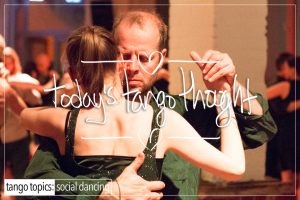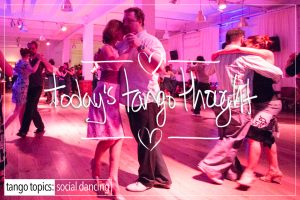Important Notation: It should be noted that what’s here in this Tango Thought is subjective which requires some latitude of translation outside of your ideas of what Tango is and is not. It may cause some consternation due to the possible hyperbole of the statements and characterizations herein. In other words, cut it some slack! This is a very difficult topic to discuss publicly, without getting reamed over the genders involved, nor the roles of Tango. However, there’s enough data on this site to make the attempt if you follow the links that are embedded here. This is not a 5-minute read, but instead will take you some time to digest and consider. Further still those that venture may feel that what follows is disparaging of their Tango accomplishments. Try not to see this post as anywhere close to that, nor the author as being high and mighty, but rather something you may want to aspire towards. “Tango is the unending onion, there’s always another layer…always”. Lastly, there’s a word in the old testament that is used between passages which means ‘to pause and reflect’, and that word is Selah. So…..
Selah
This idea is geared towards the advancing Lead that’s been dancing for ‘a while’, and not for the beginner that has just started, but as a beginning Lead you do want to pay attention to this as you will run into this type of Follower at some point. At the same time, a Follower reading this shouldn’t shy away because we’re talking about leading stuff…just the opposite, trust that there’s a whole bunch of stuff below for you as well.
To be a bit more transparent, for the advancing Lead: If you’re still have fear about the embrace, or stepping on your Follower’s feet, or you’ve still got ‘issues’ about Milonga, or for that matter Vals, then you’re still in that beginning stage of the dance. That’s nothing to be ashamed of by the way, nor is it something you should rush to change either. Take your time with this stuff, Tango takes a while to mature and grow into. More than likely you still have some physiological habits that you are unaware of that you need to address such as Creepy Hands, Head Tilt, Bumper Car Tango, just to name a few, and a host of things that need to be addressed before you can begin to dance the way that you want. 🙂 That said, pay attention to the scenario below:
You’ve been dancing a while (about two years or so) and you think of yourself as knowing what you’re doing (hahahahahaha). You’re at your local milonga and in walks a new Follower that you’ve not seen before. It’s clear from their shoes, how they walk in, and how they sit, and their general demeanor – how they carry themselves that this is not a beginner. They have this air that screams ‘experience’ about them. Whether or not there is any validity to this supposition is debatable. You’re a little scared and a little excited at the prospect of a ‘new’ person and eager to try them out. The line of the usual suspects engages in cabeceo-ing the Follower because, as it just so happens to be, this Follower is very pretty. So naturally, this elicits even more of a queue of Leads itchin’ to dance with this particular Follower! So you wait until the fervor dies down a bit, and then flash the Follower your best Cabeceo. The Follower responds!!!! Woo-hooo! So you jump from your position, walking around the floor (not across it…tsk, tsk, tsk) to get them from their chair. This Follower is clearly a classy one, as they wait until you get right up next to them to stand (very important), and you extend your hand to them. You graciously guide them to the entry point that the Milonga organizer has indicated as the entry point for the Line of Dance. You engage in a Lead Cabeceo (very important) to the oncoming Lead. The first Lead continues on, but the Second accepts and allows you entrance to the floor. You step onto the floor, and extend your embrace to the Follower and step into theirs as they do the same. You both engage in the Adjustment Phase of the Salida. And then you take your first step with each other. It’s right about this point that you discover what every other Lead in the room that has danced with them has discovered: This Lead is dancing with a Powerful Follower!
What is a Powerful Follower ? What did this lead discover in that first step that they needed to be aware of ? They discovered a Follower that has first and foremost, and quite possibly what defines this kind of Follower, a.) the force of the Follower’s muscles (legs – quads & glutes specifically) engaging with acceleration, as well as the physical strength of their steps, but not their embrace, – Forward, Side, Back, as well as controlled and contained precision Applied Disassociation. All executed without a ‘thud‘ or ‘recoil‘ effect. Instead, this Lead felt absolute precision and control coming from this Follower but with strength in each step. b.) They felt extreme confidence in coming from the Follower in their execution of their skills. c.) Containment, as well as the delicate execution, of the 7 Basic Moves. d.) They felt the Follower’s accentuated walk in the ‘Long Step’ (Forward, Side, or Back). As this was a Salida step, it was more than likely that opening Side step into the Lane of Dance. e.) They felt this Follower fully married to this Lead’s torso! Wherever this Lead went, this Follower is fully there without sacrificing their embrace, or technique, nor do they lag. This Lead felt the ‘elasticity’ in this Follower’s embrace, but without gripping the Lead’s biceps or digging their fingers/thumbs into the flesh of the Lead to maintain control or physiological contact in Close Embrace. These are just some of the things that tipped off the Lead into thinking that the Follower they’re dancing with is a Powerful Follower.
From a Following Perspective, you’re going to ask if the Follower needs to be an Active or Passive type of Follower ? The simple answer is: “No”. And certainly not in the way that Tango Topics defines these phrases: Active Follower, or Passive Follower (follow the links before reading any further, no pun intended). This isn’t about being one or the other. It’s about generating certainty in one’s steps, without hesitation, and quite factually stepping into the desired position (Walk, Ocho, Turn, Cross, etc) with momentum, strength, control, and precision. To be fair, and to be clear, this is not the type of Following that happens overnight. Nor is it something you just decide to do. No, this one takes time to develop on a variety of levels all at the same time. You’re going to ask, how do you know if you’re a Powerful Follower ? Asking your Leads will be pointless because they don’t have the language to help you. Why ? They’ll yap at you about “being-on-your-axis“, “giving resistance“, “waiting for the lead” lines of bullshit. Which is about as helpful as a small kitchen appliance that’s been unplugged. So how do you know ? You don’t. There’s way too much subjective language that’s used to describe this stuff. This is something that you quite literally have to be taught to do. But it starts by mastering the areas of Passive Following first and foremost, and secondly passing through the Role of the Active Follower (as defined above) before you can even begin to approach this idea. Again, this is not something that’s going to happen overnight, nor in any short amount of time, so get that thought right out of your head. This is about maturation, you need to grow into your skills, more than anything else. You are like a fine wine that takes it’s time to become that fine wine. Keep studying, keep pulling apart your dance, keep working on your walk, your extensions, you control over smaller and smaller and smaller positions of where and how your foot lands on the floor. Pay attention to using your arms, or hands to stabilize yourself (major no-no). Pay attention to precise and absolute control over every aspect of your body, every muscle is controlled and contained.
From a Leading Perspective, while dancing with this type of Follower sounds like it’s work and not all that pleasurable. The truth is that this type of Follower is absolutely beyond your wildest doubts so incredibly fun to dance with that you’ll lose your mind! Believe it or not, you really do want to dance with a Powerful Follower. This is a rare treat that should be appreciated when it happens for a variety of reasons. One of which is that they’ll self-correct and are seemingly effortless to dance with and their responsiveness. However, with “Great strength comes great responsibility” and a warning: They can easily overwhelm you if you’re not careful. You’ll have this certain desire to use your arms to control them or to hang on for dear life through their the Follower’s Molinete or their Argentine Crosses. If you’re doing this with this kind of Follower, then we hate to break it to you but you’re still in that beginning stage of the dance. 🙁 This type of Follower is not controlled with force, nor your arms or hands, nor engaging compression, tension, pressure or compensating force, or guided (ahem) via La Marca! Nope. The way to manage this Follower has everything to do with your walk! Trust that this Follower is hyper-aware, and will respond to every nuance you can possibly throw at them before you ever get the thought out of your cerebellum! They’re jane-on-the-spot! And if you’re lucky enough to dance with this type of Follower they can easily show you all the places where you’re lacking in less than 5 steps. You’re going to feel like an idiot if you’re not used to this kind of Follower, there’s no way around that one, assuming you don’t have an ego the size of Montana and think that you’re Jesus H. Christ that walks on water with your skills.
The Tango Topics Opinion: Powerful Follower ? You should absolutely strive towards this ideal to dance like and to dance with. In this space both Lead and Follow take ownership of their dance in a co-complimentary way by being ‘Strong Equals’ to each other. This state of the Powerful Follower is a necessary stepping stone to generating this idea.
Sadly, far too often most Followers are exceedingly hesitant to do X, Y, or Z for a variety of reasons. Most notably because of the Leads they dance with, and the culture that they dance in, co-create subservience instead of egalitarianism! The Leads that Followers dance with want ‘compliant’, rag dolls Followers, without a thought in their heads.
Mind you, there are some Followers that like this idea, they dislike the characterization of the ‘rag doll’ because they don’t see themselves like that, but they want to let go of themselves. They believe in ‘losing themselves’ in their Lead. They don’t want to think. They don’t want to be in control. They want to subjugate themselves to someone else’s thought or whims. This thought and practice is very appealing to them.
Then there’s the aspect that this characterization is what most people define or think of as traditional and historical of Tango. The Lead proposes and the Follower does what was proposed. However, where there’s some wiggle room is that no where in that proposition and doing does it say anything about the Follower not fully engaging with what they’re being led to do! Not taking ownership of their steps. Nor not being responsible for their own actions. The Follower is being led, yes. But how the Follower executes X, Y, or Z is entirely up to them. The Lead may propose, suggest, invite…and sadly, force (uuuugh, and tsk, tsk, tsk on the Lead that does that) the Follower to X, Y, or Z. But it is the Follower that has the opportunity sometimes not fully due to the time aspect of what’s being led in time to the music, to execute. And in that execution they have the ability to fully explore, engage, and to agency with your own steps.
There are some that will vehemently disagree with these sentiments. And there are some that will see this as absolute heresy. However, if you stop and you think about it, which would you rather Lead, the rag doll ? or the strong and powerful who in the end will make the Lead, and themselves, look and feel 10 times better. Think of it as the difference between catching a dead fish vs. catching a fish with life in them that doesn’t want to be caught! Which one do you want ? More than likely the fish with life in them!
That lively fish ? This is the Powerful Follower you want to be and to dance with from the Tango Topics Opinion.
- Glossary: Applied Disassociation
- Glossary: Contact
- Glossary: Follower's Molinete
- Glossary: Active Follower
- Glossary: 7 Basic Moves
- Glossary: Close Embrace
- Glossary: Lead Cabeceo
- Glossary: Compression
- Glossary: Head Tilt
- Glossary: Resistance
- Glossary: Pressure
- Glossary: La Marca
- Glossary: Milonga
- Glossary: Cabeceo
- Glossary: Pulling
- Glossary: Leading
- Glossary: Cross
- Glossary: Tension
- Glossary: Walking
- Glossary: Salida
- Glossary: Lead
- Glossary: Force
- Glossary: Ochos
- Glossary: Molinete











